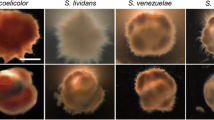Abstract
In vitro transformation of ampicillin to cephalexin was studied using calcium alginate-immobilized and freeStreptomyces sp. strain DRS-1 packed in glass columns. Tris-HCl buffer containing ampicillin was continuously circulated through the columns for four cycles, each cycle (with fresh ampicillin) being continued for 5 h. The pattern of product formation was identical in both cases,i.e. in each cycle, after reaching a certain concentration, its formation did not increase. Product formation was always higher with immobilized cells. Conversion of ampicillin to cephalexin by the strain was affected by cell and substrate concentration.
Similar content being viewed by others
References
Atrat P., Groh H.: Steroid transformation with immobilized microorganisms.Z. Allg. Mikrobiol. 21, 3–6 (1981).
Baldwin J.E.: Recent advances in penicillin biosynthesis, pp 62–65 in A.G. Brown, S.M. Roberts (Eds):Proc. 3rd Symp. Recent Advances in Chemistry of β-lactam Antibiotics. The Royal Soc. Chem., London 1985.
Constantinides A.: Steroid transformation at high substrate concentration using immobilizedC. simplex cellsBiotechnol. Bioeng. 22, 119–136 (1980).
Freeman A., Blank T., Aharonowitz Y.: Protein determination of cells immobilized in cross linked synthetic gels.Eur. J. Appl. Microbiol. Biotechnol. 14, 13–15 (1982).
Fukui S., Tanaka A.: Bioconversion of lipophilic compounds by immobilized microbial cells in organic solvents.Acta Biotechnol. 1, 339–350 (1981).
Fukui S., Tanaka A.: Immobilized microbial cells.Ann. Rev. Microbiol. 36, 145–172 (1982).
Jensen J.E.: Biosynthesis of cephalosporins.Crit. Rev. Biotechnol. 3, 277–301 (1986).
Kupka J., Shen Y.Q., Wolfe S., Demain A.L.: Partial purification and properties of the α-ketoglutarate linked ring expansion enzyme of β-lactam biosynthesis ofC. acremonium.FEMS Microbiol. Lett. 16, 1–6 (1983).
Kohsaka M., Demain A.L.: Conversion of penicillin N to cephalosporins by cell free extract ofC. acremonium.Biochem. Biophys. Res. Commun. 70, 465–473 (1976).
Khang Y.H., Shankar H., Senatore F.: Comparison of free and immobilizedCephalosporium acremonium for β-lactam antibiotic production.Biotechnol. Lett. 10, 719–724 (1988a).
Khang Y.H., Shankar H., Senatore F.: Enhanced β-lactam antibiotic production by coimmobilization of fungi and alga.Biotechnol. Lett. 10, 867–872 (1988b).
Kloosterman J., Dolly M.D.: Effect of supersaturated aqueous hydrocortisone concentrations on the 1-dehydrogenase activity of free and immobilizedA. simplex.Enz. Microbiol. Technol. 6, 113–116 (1984).
Nuesch J., Heim J., Triechter H.J.: The biosynthesis of sulphur containing β-lactam antibiotics.Ann. Rev. Microbiol. 41, 51–75 (1987).
Park Y.S., Ohta N., Okabe M.: Neomycin production by partial immobilization ofS. fradiae on cellulose beads in air-lift bioreactor.J. Ferment. Bioeng. 78, 265–268 (1994).
Roy D., Sharma A., Bhowmick G., Roy M.K., Ghosh A.C.: Characterization ofStreptomyces sp. strain DRS-1 and its ampicillin transformation product.Folia Microbiol. 42, 333–336 (1997).
Roy D., Sharma A. Roy M.K., Ghosh A.C.: An improved process for preparation of cephalexin.Indian Pat. submitted (1996).
Tanaka A., Nakajima H.: Application of immobilized growing cells.Adv. Biochem. Eng. Biotechnol. 42, 97–131 (1990).
Tanaka T., Yamoto K., Towprayoon S., Nakajima S., Sonomoto K., Kubota K., Tanaka A.: Continuous production of serine by immobilized growingCorynebacterium glycinophilum cells.Appl. Microbiol. Biotechnol. 30, 564–568 (1989).
Vaija J., Linko Y.Y., Linko P.: Citric acid production with alginate bead encapsulatedAspergillus niger. ATTC 9142.Appl. Biochem. Biotechnol. 7, 51–54 (1982).
Author information
Authors and Affiliations
Rights and permissions
About this article
Cite this article
Roy, D., Guha, A., Roy, M.K. et al. In vitro transformation of ampicillin to cephalexin by free and immobilized cells ofStreptomyces sp.. Folia Microbiol 43, 379–382 (1998). https://doi.org/10.1007/BF02818577
Received:
Revised:
Issue Date:
DOI: https://doi.org/10.1007/BF02818577



